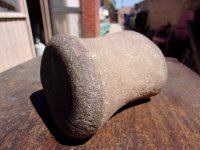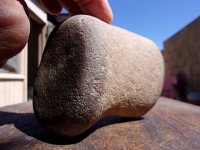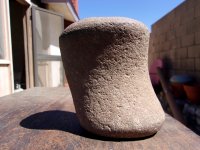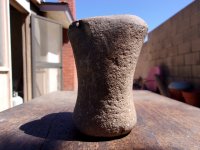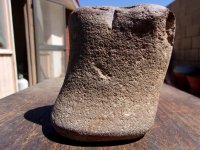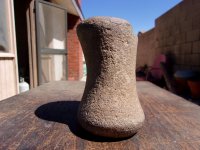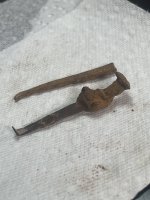Which view i,am not sure what u mean lol. this dam rock has curves everywhere. Do u mean standing up like the last photo ?
You are using an out of date browser. It may not display this or other websites correctly.
You should upgrade or use an alternative browser.
You should upgrade or use an alternative browser.
If this is natural than I give up!
- Thread starter Freemindedclark
- Start date
- Jul 27, 2006
- 48,467
- 54,921
- Detector(s) used
- Minelab_Equinox_ 800 Minelab_CTX-3030 Minelab_Excal_1000 Minelab_Sovereign_GT Minelab_Safari Minelab_ETrac Whites_Beach_Hunter_ID Fisher_1235_X
- Primary Interest:
- All Treasure Hunting
Profile, something like this --> ( Wanting to see the curve. Your bottom picture would be it if you turned it 90 degrees to the right.
Ok i will take some more thanks T_H
Swaveab
Hero Member
Could be a prehistoric ink blot test, but what would I know?

yakker
Bronze Member
- Jan 20, 2012
- 1,663
- 1,238
- Detector(s) used
- spec enhanced eyeballs
- Primary Interest:
- All Treasure Hunting
That's something that has been brought up with me before. I agree that the natives and other ancient peoples were very good working stone. That being said, where I see a problem with saying if it's not masterfully crafted then it's natural. This would imply that there was no learning curve. Also it would imply that only the most skilled( born a master) were allowed to work stones.
Your approach is wrong here. Sorry.
The original post is not an artifact- not shaped or formed by man. It is natural. There are several things to consider. Consider stone that's been sculpted at the earliest stages of known human art, and it's recognizable (and beautiful). Native American children may have created points and small stone knives, but they did not sculpt stone. Amateurs may have gained skills over time, but the marks of work are obvious. And if they're not, there's hardly a point in considering- rocks like what you have. The places that make the 'face' are smooth and shiny. If it were an amateur, those places would be rough, damaged. The places you photo- of rough spots have no significance to the whole.
I wonder. Have you ever tried to sculpt stone? Even with modern equipment, it's hard to do. And the rock you have there-- is not an easy one. If I stretch my imagination as far as I can, what you have might have been made by a very simple person- who could not develop skills, but played with tools and rocks AND IT WOULD HAVE TO BE A SOFT STONE LIKE SOAPSTONE-- NOT THE ONE YOU HAVE THERE. Again. None of the features which denote the face you see are rough, fractured. They're smooth-- as though someone were truly pleased with what they had and took great pains-- and a LOT of time to smooth those features out. NO. No one would take that time with something so poorly done. When an amateur is in the process of learning, they watch, they practice, they smash and break a lot of stone. ONLY when they get it right- and beautiful- do they take the time and effort to smooth and soften the features. If you do not understand the nature of the stone being sculpted, then you have no right to blindly march forth and proclaim it a man-made stone sculpture. That's just not giving proper credit to your ancient fellow human beings. Don't you see? It's NOT like finger painting -- or even working with clay. Stone takes time and effort. If things are going wrong (and many can due to both skills AND the nature of the stone itself), the artist/sculpter does Not keep going- and 'finish' it. That would be pointless. And history of ancient stone art tells us that beautiful stone sculpture has been manufactured by human hands for as long as 800,000 years. But not on this continent. On top of that, when you look at the most rudimentary stone sculpture, the 'artist' did NOT choose the hardest rock in the pile. He chose the softest one he could find. For reasons which should be obvious. YOU try chiseling even a little line into that rock-- or one similar. See how far you get. Really. You won't understand until you do.
It helps to know geology and the specific nature- or identifying features of the rock available in the area a potential stone sculpture was created, and it also helps to understand the skills necessary to accomplish such a task. If you do not understand either of these two basic things, you are at a severe disadvantage when it comes to being able to identify accurately a true artifact; a true archaeological artifact.
You can put lipstick on a sow, but she will never be the Mona Lisa.
Keep looking. Never give up. But for the love of Mike, be realistic in your expectations when it comes to stone art.
Whiplash016
Full Member
- Feb 4, 2018
- 101
- 45
- Primary Interest:
- All Treasure Hunting
New photos. Hope this works lol.
I can’t see clear images of this while using the app on my phone, but I’m gonna comment anyway. Is it possible this is a silicified fossil vertebrae? Silicified bone can be weathered and have this exact appearance. The only way to know for sure is to cut the end with a diamond blade and check the cross section if it is bone, you’ll know it.
I can’t see clear images of this while using the app on my phone, but I’m gonna comment anyway. Is it possible this is a silicified fossil vertebrae? Silicified bone can be weathered and have this exact appearance. The only way to know for sure is to cut the end with a diamond blade and check the cross section if it is bone, you’ll know it.
I dont think bone, it is weathered stone or some kind of grinding tool idk.
Whiplash016
Full Member
- Feb 4, 2018
- 101
- 45
- Primary Interest:
- All Treasure Hunting
Your approach is wrong here. Sorry.
The original post is not an artifact- not shaped or formed by man. It is natural. There are several things to consider. Consider stone that's been sculpted at the earliest stages of known human art, and it's recognizable (and beautiful). Native American children may have created points and small stone knives, but they did not sculpt stone. Amateurs may have gained skills over time, but the marks of work are obvious. And if they're not, there's hardly a point in considering- rocks like what you have. The places that make the 'face' are smooth and shiny. If it were an amateur, those places would be rough, damaged. The places you photo- of rough spots have no significance to the whole.
I wonder. Have you ever tried to sculpt stone? Even with modern equipment, it's hard to do. And the rock you have there-- is not an easy one. If I stretch my imagination as far as I can, what you have might have been made by a very simple person- who could not develop skills, but played with tools and rocks AND IT WOULD HAVE TO BE A SOFT STONE LIKE SOAPSTONE-- NOT THE ONE YOU HAVE THERE. Again. None of the features which denote the face you see are rough, fractured. They're smooth-- as though someone were truly pleased with what they had and took great pains-- and a LOT of time to smooth those features out. NO. No one would take that time with something so poorly done. When an amateur is in the process of learning, they watch, they practice, they smash and break a lot of stone. ONLY when they get it right- and beautiful- do they take the time and effort to smooth and soften the features. If you do not understand the nature of the stone being sculpted, then you have no right to blindly march forth and proclaim it a man-made stone sculpture. That's just not giving proper credit to your ancient fellow human beings. Don't you see? It's NOT like finger painting -- or even working with clay. Stone takes time and effort. If things are going wrong (and many can due to both skills AND the nature of the stone itself), the artist/sculpter does Not keep going- and 'finish' it. That would be pointless. And history of ancient stone art tells us that beautiful stone sculpture has been manufactured by human hands for as long as 800,000 years. But not on this continent. On top of that, when you look at the most rudimentary stone sculpture, the 'artist' did NOT choose the hardest rock in the pile. He chose the softest one he could find. For reasons which should be obvious. YOU try chiseling even a little line into that rock-- or one similar. See how far you get. Really. You won't understand until you do.
It helps to know geology and the specific nature- or identifying features of the rock available in the area a potential stone sculpture was created, and it also helps to understand the skills necessary to accomplish such a task. If you do not understand either of these two basic things, you are at a severe disadvantage when it comes to being able to identify accurately a true artifact; a true archaeological artifact.
You can put lipstick on a sow, but she will never be the Mona Lisa.
Keep looking. Never give up. But for the love of Mike, be realistic in your expectations when it comes to stone art.
I have evidence of sculpted rock artwork and stone tools that are African and European style technology, but none of it is accepted. There are dozens of cultural sites across the country where the same style artifacts were found and they were shutdown. (Ex: Calico archaeological site)
Some of these sites were inhabited by multiple cultures that were more recent so the older stone tools were considered geofacts and the more modern artifacts were published because these sites were too well known to be dismissed. I’m talking about sites like the Rockshelter in PA that contained Neanderthal stone tools and artwork.
The great serpent mound in Peebles, Ohio located 152 miles southwest of my land also contained Acheulean and Mousterian style stone tools. One more example is the Alligator Mound, at the Newark Earthworks site. I guess no one asked why an alligator mound was built by the Hopewell Indians in a state that doesn’t have alligators.
I made a map that shows a direct line from my land through the Alligator mound in Newark to the serpent mound in Peebles. The first green rock art face carving was found at The Newark Earthworks site, but was never published and considered a geofact. The second green face carving was found in France at a Neanderthal site dated 250kya and accepted as an artifact. The next few images are from my land. This is not coincidental. The stone tools on my land are Acheulean and Mousterian style and found with petrified fossil remains from reptiles and mammals that are not supposed to be found in Ohio, but I won’t post those because almost everyone here called them geofacts when they clearly are not.
My land was never eroded by the ice age which is why all of this stuff is still here, it’s literally everywhere on this 3.5 acre square on the highest hill around.
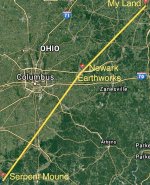
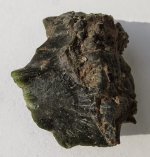
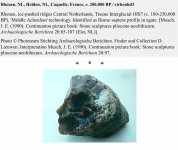
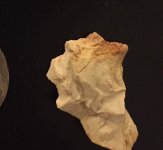
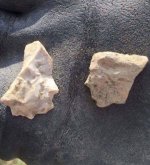
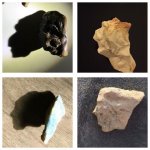
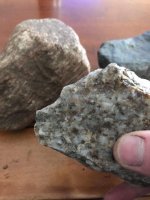
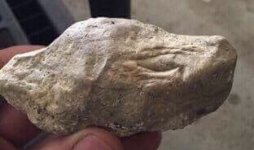
All I see is natural rocks and debitage. Including the one from Europe. Gary
Swaveab
Hero Member
I'm seeing side heads on 2 of them so kind of interesting to keep.
NEPA History
Jr. Member
- Apr 12, 2018
- 91
- 294
- Detector(s) used
- Garrett Ace 400
- Primary Interest:
- All Treasure Hunting
In my 30 or so years of collecting and searching for native American artifacts experience, I would have to agree with most here that what you found is not an artifact, but an interesting looking water worn stone. The human brain is a funny thing, it sees patterns and faces in nature that aren't really there. It's what the brain does because it's how we recognize faces of those we know. There are small artifacts made of stone that were made, but it's obvious that they were intentionally worked. And they are much more rare than say, a stone projectile point or a hide scraper, so coming across one is extremely rare on a good day. Don't give up though..the hunt is sometimes more rewarding than the find. Get yourself some books on common Native American artifacts found in your area and you can get a better idea of what you are looking for. No disrespect intended, just wanted to give you my opinion and advice! Don't give up, good luck out there!
Whiplash016
Full Member
- Feb 4, 2018
- 101
- 45
- Primary Interest:
- All Treasure Hunting
These aren’t Native American Artifacts. They are a lot older than that.
Whiplash016
Full Member
- Feb 4, 2018
- 101
- 45
- Primary Interest:
- All Treasure Hunting
I found petrified remains all over the place and silicified bones, teeth, and some are covered in a strange material that I cannot identify. I’ll post a photo of what I’m talking about. There’s a section on this piece where the exterior layer broke off and it exposed the bone underneath. It’s 100% bone, that was encase and preserved very well.
This has a layer of whatever this is covering it. It’s bone underneath and I am point that out in these three images.
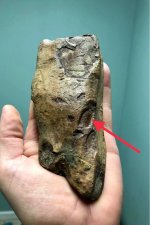
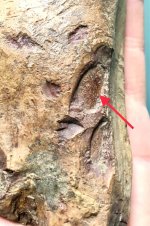
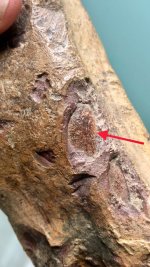
This has a layer of whatever this is covering it. It’s bone underneath and I am point that out in these three images.



Holyground
Hero Member
- May 17, 2014
- 579
- 828
- Detector(s) used
- Garrett AT GOLD, Garrett ATX
- Primary Interest:
- All Treasure Hunting
Boy there's a great head knocker! Throw it at the next person you see, then run!
T.C.
Bronze Member
- May 17, 2012
- 2,417
- 3,796
- Detector(s) used
- Whites M6
- Primary Interest:
- All Treasure Hunting
the age of Lizard People ?
I have to somewhat agree with Michelle S
I say there is a 50/50 chance on it being altered sometime in it's 50,000.000
or so years on earth.
View attachment 1629045
but of course, I'm more open minded, then I am willing to admit
Geologists & archeologists know less than crap about our Planets History
over the last Zillion or so eons the Universe & planets Really were here
Space is Unlimited, so is Time. there can be no Beginning & no end to space & time. without Space & time before & after, Space & time.
Add to that, You can't create something from nothing.
so something had to be here forever. and longer.
& even before That
Either way.
It's a Keeper imo
I do agree with T.H. though that Geofact is the Right place till
it can be Confirmed 100%
Find it's Twin to show the Artist Existed.


T.C.
Bronze Member
- May 17, 2012
- 2,417
- 3,796
- Detector(s) used
- Whites M6
- Primary Interest:
- All Treasure Hunting
" I'd rather surround myself with 1-percenter artifacts just as I'd rather surround myself with 1-percenter intellects, but if you are satisfied by the company of glue-eaters and their artifact equivalents then by all means continue gorging yourself on that "special" low-hanging fruit. The more people investing time in the mediocre the less competition there is for the good stuff, so if you're hell-bent on filling your property with plain rocks then knock yourself out if it truly makes you happy."
ROTFLMFAO!! Very well put!
ROTFLMFAO!! Very well put!
Whiplash016
Full Member
- Feb 4, 2018
- 101
- 45
- Primary Interest:
- All Treasure Hunting
I have fossil reptile remains in the same sediment as stone tools and rock art. Is it coincidental that there’s also stone carved reptile heads? I know your post is aimed at the original poster, but I’m on to something with what I’ve posted here in the last few comments.
Top Member Reactions
-
 2254
2254 -
 1124
1124 -
 1025
1025 -
 910
910 -
 858
858 -
 773
773 -
 772
772 -
 736
736 -
 609
609 -
 494
494 -
 486
486 -
 483
483 -
O
439
-
 431
431 -
 417
417 -
 412
412 -
 406
406 -
 387
387 -
 381
381 -
 378
378
Users who are viewing this thread
Total: 2 (members: 0, guests: 2)



